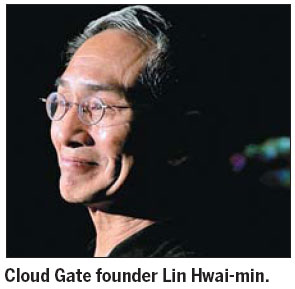Dance between the lines
Updated: 2013-03-08 07:33
By Raymond Zhou (China Daily)
|
|||||||||||
|
Nine Songs, a production by Asia's foremost dance company Cloud Gate, is a poetic tribute to those we should hold in reverence. Photos provided to China Daily |
To fully appreciate Nine Songs, audiences need to know more than the Chinese language and culture. Raymond Zhou reviews.
Lin Hwai-min's Nine Songs is more than a recreation of ancient rituals or an amalgam of pagan extravaganzas. It is a perfect fusion of the past and the present. As a matter of fact, it subtly portrays the progress of spiritual activities as refracted through the modern prism. Nine Songs was originally a cycle of poems by Qu Yuan, a poet of the Chu Kingdom who lived some 2,300 years ago, before China became a unified country.
However, it did not seem to be the intention of the Cloud Gate founder and choreographer to faithfully recapture the content of the poem through the body language, but rather, he wanted to use it as a kind of springboard to pay tribute to all those whom we should hold in reverence.
Chinese, or Asians in general, do not worship only one god. We have all kinds of gods and goddesses. And you do not need to know who they are or what they do to understand the rites of each number. It takes an ethnologist or anthropologist to decipher the origin of each rite as Lin has taken liberally from all kinds of sources, including Taiwan indigenous tribes, cave carvings from Northwestern China, and harvesting celebrations from Indonesia.
The penultimate number does require some knowledge of the Chinese language and Chinese history as names are chanted out in Mandarin and Taiwanese dialect over a long sequence for which men and women are gagged and executed.
These are Chinese heroes who sacrificed their lives for the sake of their nation. We worship them in the same sense our ancestors worshipped their gods and goddesses. With one touch, Lin connected esoteric shamanism with the modern legacy that binds the Chinese people.
Artistically, Nine Songs is a calculated study in contrast. Ming Cho Lee's set design is uncharacteristically realistic - for a modern dance piece.

For one thing, there is a lotus pond downstage complete with water, well, actually outside the proscenium where the orchestra pit is. On top of that, rows of stage curtains on both top and sides are replaced with giant panels of lotuses, which are inspired by a lotus painting by Taiwan artist Lin Yu-san. The giant moon for the backdrop looks like it was lifted from a Broadway musical.
Yet, within this true-to-life frame, the action is nothing but abstract.
Of course, the lotus carries rich layers of symbolic meanings in Chinese culture. It denotes purity and integrity though rooted in watery mud. It is also a homonym for harmony and unity as well as a Buddhist avatar for rebirth. Visually, it is emblematic of tranquility and nobility.
The predominant image from the shamanist rituals is a naked man wearing a mask. He moves in slow and exaggerated motions. On the other hand, the few modern men - one dressed in suit and carrying a suitcase - walk briskly, some even on rollerblades. Their bodies are fully clad, yet their faces are not covered. Both ancient and modern people are somewhat aloof, but it's easy to see the former are closer to the nature that surrounds them.
It is also fascinating that some of the ancient rituals are quite orgiastic, suggestive of a merge of physical and spiritual pursuits. The movements are indecipherable yet mesmerizing. And the music from India, Japan, Java, Tibet and other parts of China, as well as the sound effects, are haunting. They at once point backwards and upwards - to a state of mind where one is in touch with not just a higher being, but with nature and with oneself.
The final scene of 800 lanterns forming a meandering river of lights is a poetic memorial to all those lives gone but not forgotten.
Nine Songs was created in 1993 for the 20th anniversary of the founding of Cloud Gate, now Asia's foremost dance company.
Recently, three shows were given in Beijing to an enthusiastic reception. It will continue its tour to Shanghai, Hangzhou, Guangzhou and Chong-qing and will be expanded to European cities including London and Moscow.
Contact the writer at raymondzhou@chinadaily.com.cn.
(China Daily 03/08/2013 page18)
Today's Top News
Police continue manhunt for 2nd bombing suspect
H7N9 flu transmission studied
8% growth predicted for Q2
Nuke reactor gets foreign contract
First couple on Time's list of most influential
'Green' awareness levels drop in Beijing
Palace Museum spruces up
Trading channels 'need to broaden'
Hot Topics
Lunar probe , China growth forecasts, Emission rules get tougher, China seen through 'colored lens', International board,
Editor's Picks

|

|

|

|

|

|






